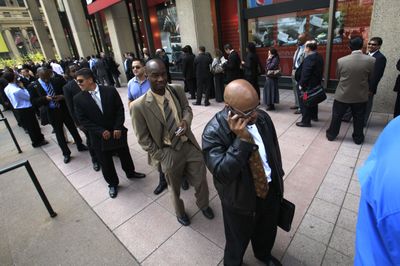Jobless reports tell different stories
Q-and-A

One week, a federal report says the number of people filing new claims for unemployment insurance has unexpectedly dropped, pointing to a slowdown in layoffs. Good news, right? Maybe not.
Within weeks, another government report says the unemployment rate has climbed. Bad news? Not so fast: Soon a privately issued report says the labor market appears to be strengthening, news that reassures investors and sends stocks higher.
Confused yet? Don’t worry – so are some of the nation’s leading economists.
Gauging the labor market, and predicting where it might go, has proven to be an exceedingly difficult task during this fast-moving recession. The unemployment rate has spiked much faster than most analysts thought it would over the last year, and along the way numerous reports has given seemingly contradictory messages about the number of Americans out of work.
So which reports should be trusted, and which ones tell the whole story? Is the report on jobless claims released Thursday – which said that new claims dropped slightly to 631,000 – simply going to be contradicted by the next set of numbers? How do agencies even know how many jobs have been slashed?
Here are questions and answers about the main jobs reports that experts consult to read the labor market.
Q. What are the most important reports that experts watch?
A. Two major government reports get the most attention: the weekly jobless claims report filed by the Department of Labor, and the monthly unemployment report from the Bureau of Labor Statistics. These are complemented by a slew of private reports issued by economic consultants such Moody’s Economy.com or Automatic Data Processing Inc.
Q. What does the report on weekly jobless claims measure?
A. The report captures the number of people who file their first claim for unemployment insurance after being laid off. This can be a good measure for how many jobs were cut the week before, but it doesn’t capture the whole picture. Not everyone who loses their job ends up filing for unemployment insurance benefits, or at least not right away. Still, the rough number can point to trends in the labor market between monthly reports filed by the Bureau of Labor Statistics.
Q. What does the monthly unemployment report measure?
A. The monthly unemployment report is based on a Census Bureau survey of 60,000 U.S. households. The survey asks respondents several questions, including whether they have a job, are looking for a job, or have quit looking for work altogether.
The report lays out a range of unemployment rates. The most- cited rate only counts people actively looking for work; the latest unemployment report, released May 8, calculated that rate as 8.9 percent. A broader rate – 15.8 percent in the latest report – includes everyone who has dropped out of the labor force or has been forced into part-time work.
Q. Why do these reports seem to contradict each other sometimes?
A. The main reason is that the jobless claims report only catches one piece of the puzzle – the number of jobs being shed. But sometimes, the rate can climb even if fewer jobs are cut. That’s because the rate also accounts for the all-important factor of job creation.
Q. So which reports should I pay attention to?
A. You can’t go wrong by watching the monthly unemployment report from the Bureau of Labor Statistics, said Arindrajit Dube, an economist with the Center for Labor Research and Education at the University of California at Berkeley. The unemployment report is the best gauge of the labor market because it measures people’s intentions – such as whether they’ve given up on the job hunt or decided to return to school – in a way payroll figures or jobless claims cannot.